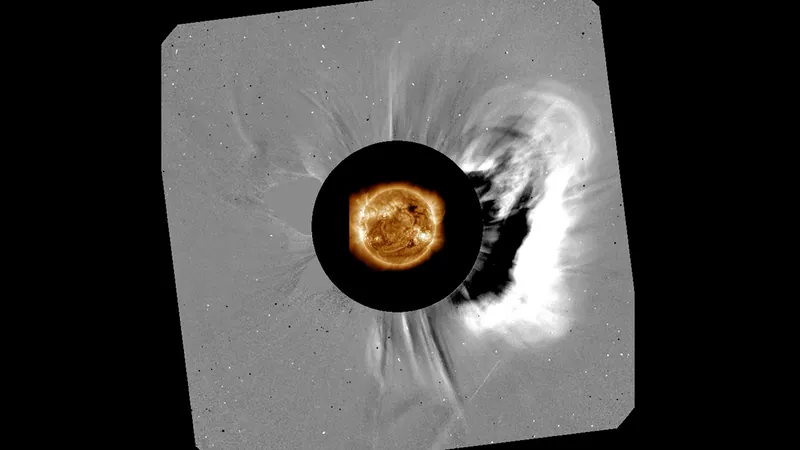
Experience the Stunning Solar Spectacle That Left the World in Awe!
2025-01-02
Author: Nur
Experience the Stunning Solar Spectacle That Left the World in Awe!
In an extraordinary display of cosmic artistry, the night skies around the world transformed into a vibrant canvas of colorful auroras in Spring 2024. For an astonishing 48 hours, citizens from the sunny beaches of Florida to the serene landscapes of New Zealand gazed in wonder at this spectacular atmospheric light show, which was unusually visible far beyond typical latitudes.
These mesmerizing auroras were a direct result of chaotic explosions on the Sun just days before. In early May, a dynamic area on the Sun, known as an active region, unleashed a barrage of charged particles and radiation into the solar system. Such solar events, while often magnificent, can pose serious risks by disturbing electrical systems in spacecraft and sending charged particles hurtling toward planetary bodies, potentially affecting power grids and satellite communications on Earth.
Fortunately, this particular series of storms was mostly harmless. What made this event even more significant was the unprecedented number of solar probes that were monitoring these solar activities. Unlike in the past—when spacecraft studying the Sun were restricted to observing from Earth’s perspective—advancements in space technology, highlighted by the launch of the European Space Agency's Solar Orbiter in 2020, have allowed for continuous monitoring of the Sun. The Solar Orbiter, along with a constellation of other spacecraft, now provides scientists with a comprehensive view of solar phenomena as they unfold, especially during the Sun's 27-day rotation cycle.
“This is fundamentally changing our approach to solar research,” stated George Ho, a prominent space physicist at the Southwest Research Institute. The findings from May demonstrated the importance of this technology. By integrating observations from multiple spacecraft, scientists were able to piece together the activity of the active region, leading to a deeper understanding of how solar forces interact with Earth's magnetic field.
Active solar regions like these can produce dangerous phenomena such as coronal mass ejections (CMEs), solar flares, and radiation storms. In May and June, the hyperactive area erupted repeatedly, launching a series of CMEs and flares that riveted the attention of researchers. "It was an exceptionally intense active region," noted NASA astrophysicist David Lario.
Interestingly, the impact of these solar events can reach Earth even when the source lies hidden from direct view. The Sun's magnetic field lines extend into space, and when they connect with Earth’s magnetic field, they create pathways for charged particles to travel toward our planet. This intricate dance of magnetism means that even solar phenomena occurring on the far side of the Sun can have pronounced effects on our atmosphere.
Utilizing data from Solar Orbiter and other spacecraft such as the Solar Terrestrial Relations Observatory (STEREO) A and Geostationary Operational Environmental Satellites (GOES), scientists meticulously tracked the activity from the active region over two rotations. On May 20, a powerful solar flare was detected, which was significant despite the active region being on the far side of the Sun. The research team proposed that even though the magnetic bridge to Earth was weak, charged particles managed to traverse the magnetic fields.
The Solar Orbiter has already recorded even more intense solar events than those in May and June, but they occurred when Earth was not in the line of fire. "It appears we dodged the biggest bullet," remarked Ho, reflecting on the fortunate positioning during these powerful events.
As we continue to explore the mysteries of our solar system, the remarkable capabilities of the Solar Orbiter mark a new era in our understanding of solar dynamics and their profound effects on our planet. Scientists are now better equipped to comprehend the complexities of how our Sun influences Earth, in ways that once seemed almost mystical. The breathtaking auroras witnessed around the globe remind us not just of the beauty of our universe, but of the powerful cosmic forces at play just beyond our atmosphere.

 Brasil (PT)
Brasil (PT)
 Canada (EN)
Canada (EN)
 Chile (ES)
Chile (ES)
 Česko (CS)
Česko (CS)
 대한민국 (KO)
대한민국 (KO)
 España (ES)
España (ES)
 France (FR)
France (FR)
 Hong Kong (EN)
Hong Kong (EN)
 Italia (IT)
Italia (IT)
 日本 (JA)
日本 (JA)
 Magyarország (HU)
Magyarország (HU)
 Norge (NO)
Norge (NO)
 Polska (PL)
Polska (PL)
 Schweiz (DE)
Schweiz (DE)
 Singapore (EN)
Singapore (EN)
 Sverige (SV)
Sverige (SV)
 Suomi (FI)
Suomi (FI)
 Türkiye (TR)
Türkiye (TR)
 الإمارات العربية المتحدة (AR)
الإمارات العربية المتحدة (AR)